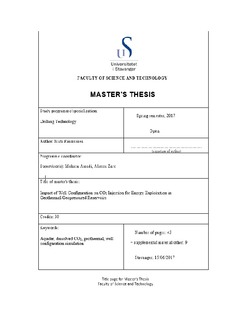| dc.contributor.advisor | Assadi, Mohsen | |
| dc.contributor.advisor | Zare, Alireza | |
| dc.contributor.author | Rasmussen, Mats | |
| dc.date.accessioned | 2017-10-24T11:46:58Z | |
| dc.date.available | 2017-10-24T11:46:58Z | |
| dc.date.issued | 2017-06 | |
| dc.identifier.uri | http://hdl.handle.net/11250/2461801 | |
| dc.description | Master's thesis in Petroleum engineering | nb_NO |
| dc.description.abstract | Injecting dissolved CO2 into deep saline aquifers is one of the more promising methods of alleviating greenhouse gas emissions. By simultaneously extracting the geothermally-heated brine in the aquifer, there is an opportunity to offset the energy consumption required by carbon capture and storage. This study uses a simulation tool to explore the effect of well placement on CO2-storing efficiency. Eight models with different well configurations were tried on a homogeneous aquifer. The study found that storing efficiency was heavily reliant on distance, especially vertical, between the wells and the vertical- to horizontal permeability ratio. For a given aquifer model, there exists a depth differential between wells that optimize injection- and production rates versus gas-breakthrough time. | nb_NO |
| dc.language.iso | eng | nb_NO |
| dc.publisher | University of Stavanger, Norway | nb_NO |
| dc.relation.ispartofseries | Masteroppgave/UIS-TN-IPT/2017; | |
| dc.subject | petroleumsteknologi | nb_NO |
| dc.subject | petroleum engineering | nb_NO |
| dc.subject | boreteknologi | nb_NO |
| dc.subject | drilling | nb_NO |
| dc.title | Impact of Well Configuration on CO2 Injection for Energy Exploitation in Geothermal/Geopressured Reservoirs | nb_NO |
| dc.type | Master thesis | nb_NO |
| dc.subject.nsi | VDP::Teknologi: 500::Berg‑ og petroleumsfag: 510::Petroleumsteknologi: 512 | nb_NO |
